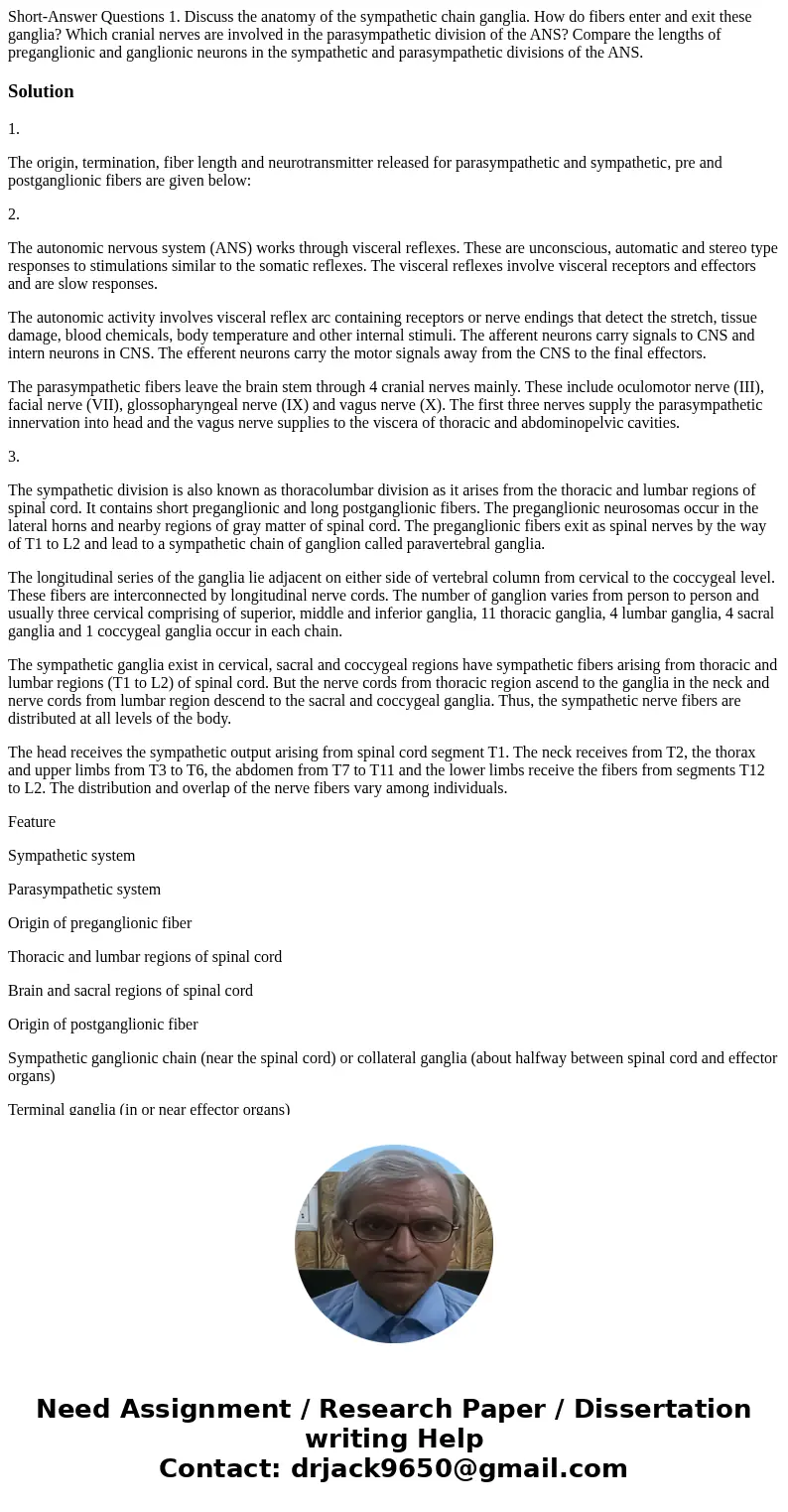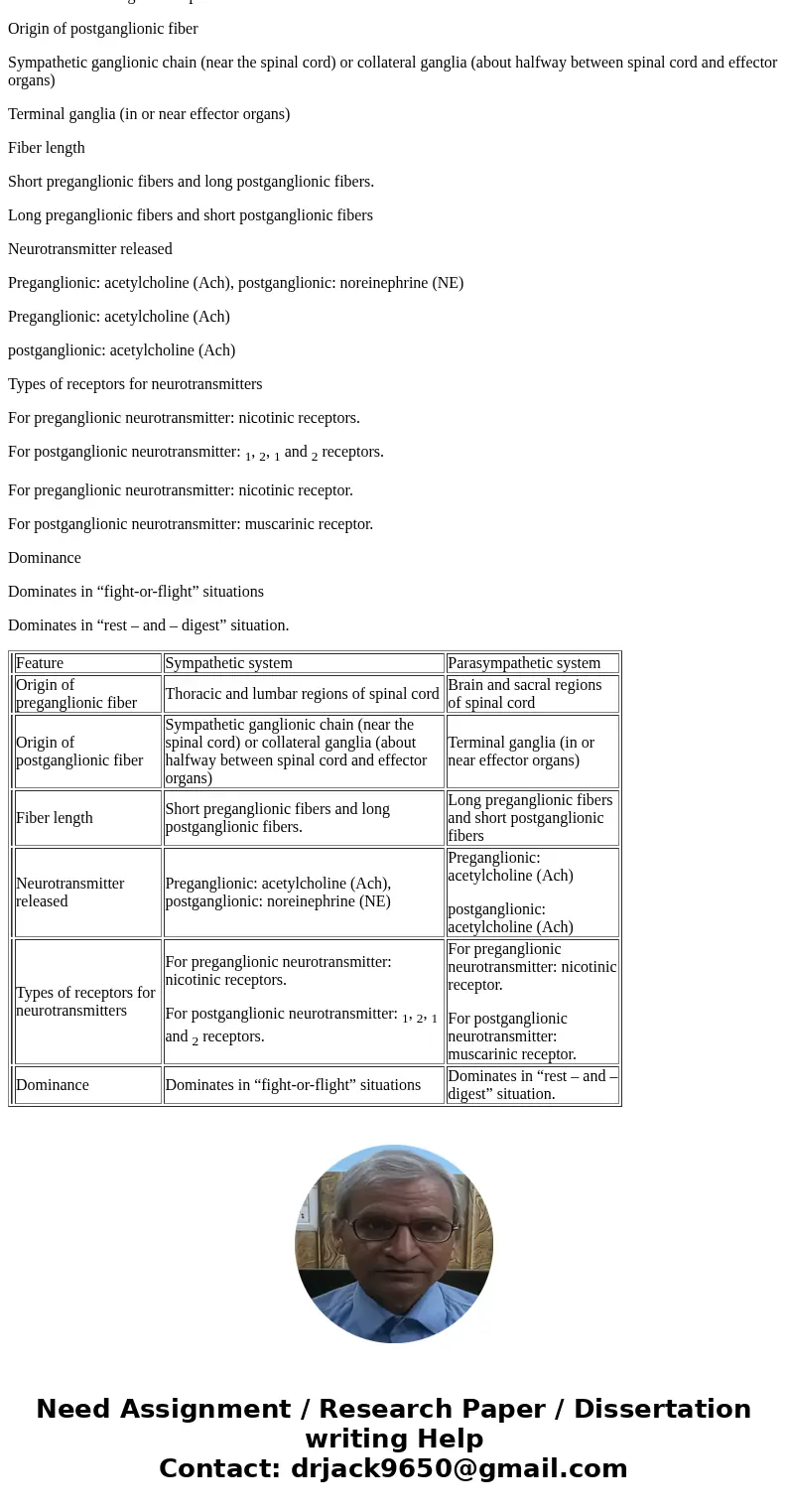ShortAnswer Questions 1 Discuss the anatomy of the sympathet
Solution
1.
The origin, termination, fiber length and neurotransmitter released for parasympathetic and sympathetic, pre and postganglionic fibers are given below:
2.
The autonomic nervous system (ANS) works through visceral reflexes. These are unconscious, automatic and stereo type responses to stimulations similar to the somatic reflexes. The visceral reflexes involve visceral receptors and effectors and are slow responses.
The autonomic activity involves visceral reflex arc containing receptors or nerve endings that detect the stretch, tissue damage, blood chemicals, body temperature and other internal stimuli. The afferent neurons carry signals to CNS and intern neurons in CNS. The efferent neurons carry the motor signals away from the CNS to the final effectors.
The parasympathetic fibers leave the brain stem through 4 cranial nerves mainly. These include oculomotor nerve (III), facial nerve (VII), glossopharyngeal nerve (IX) and vagus nerve (X). The first three nerves supply the parasympathetic innervation into head and the vagus nerve supplies to the viscera of thoracic and abdominopelvic cavities.
3.
The sympathetic division is also known as thoracolumbar division as it arises from the thoracic and lumbar regions of spinal cord. It contains short preganglionic and long postganglionic fibers. The preganglionic neurosomas occur in the lateral horns and nearby regions of gray matter of spinal cord. The preganglionic fibers exit as spinal nerves by the way of T1 to L2 and lead to a sympathetic chain of ganglion called paravertebral ganglia.
The longitudinal series of the ganglia lie adjacent on either side of vertebral column from cervical to the coccygeal level. These fibers are interconnected by longitudinal nerve cords. The number of ganglion varies from person to person and usually three cervical comprising of superior, middle and inferior ganglia, 11 thoracic ganglia, 4 lumbar ganglia, 4 sacral ganglia and 1 coccygeal ganglia occur in each chain.
The sympathetic ganglia exist in cervical, sacral and coccygeal regions have sympathetic fibers arising from thoracic and lumbar regions (T1 to L2) of spinal cord. But the nerve cords from thoracic region ascend to the ganglia in the neck and nerve cords from lumbar region descend to the sacral and coccygeal ganglia. Thus, the sympathetic nerve fibers are distributed at all levels of the body.
The head receives the sympathetic output arising from spinal cord segment T1. The neck receives from T2, the thorax and upper limbs from T3 to T6, the abdomen from T7 to T11 and the lower limbs receive the fibers from segments T12 to L2. The distribution and overlap of the nerve fibers vary among individuals.
Feature
Sympathetic system
Parasympathetic system
Origin of preganglionic fiber
Thoracic and lumbar regions of spinal cord
Brain and sacral regions of spinal cord
Origin of postganglionic fiber
Sympathetic ganglionic chain (near the spinal cord) or collateral ganglia (about halfway between spinal cord and effector organs)
Terminal ganglia (in or near effector organs)
Fiber length
Short preganglionic fibers and long postganglionic fibers.
Long preganglionic fibers and short postganglionic fibers
Neurotransmitter released
Preganglionic: acetylcholine (Ach), postganglionic: noreinephrine (NE)
Preganglionic: acetylcholine (Ach)
postganglionic: acetylcholine (Ach)
Types of receptors for neurotransmitters
For preganglionic neurotransmitter: nicotinic receptors.
For postganglionic neurotransmitter: 1, 2, 1 and 2 receptors.
For preganglionic neurotransmitter: nicotinic receptor.
For postganglionic neurotransmitter: muscarinic receptor.
Dominance
Dominates in “fight-or-flight” situations
Dominates in “rest – and – digest” situation.
| Feature | Sympathetic system | Parasympathetic system | |
| Origin of preganglionic fiber | Thoracic and lumbar regions of spinal cord | Brain and sacral regions of spinal cord | |
| Origin of postganglionic fiber | Sympathetic ganglionic chain (near the spinal cord) or collateral ganglia (about halfway between spinal cord and effector organs) | Terminal ganglia (in or near effector organs) | |
| Fiber length | Short preganglionic fibers and long postganglionic fibers. | Long preganglionic fibers and short postganglionic fibers | |
| Neurotransmitter released | Preganglionic: acetylcholine (Ach), postganglionic: noreinephrine (NE) | Preganglionic: acetylcholine (Ach) postganglionic: acetylcholine (Ach) | |
| Types of receptors for neurotransmitters | For preganglionic neurotransmitter: nicotinic receptors. For postganglionic neurotransmitter: 1, 2, 1 and 2 receptors. | For preganglionic neurotransmitter: nicotinic receptor. For postganglionic neurotransmitter: muscarinic receptor. | |
| Dominance | Dominates in “fight-or-flight” situations | Dominates in “rest – and – digest” situation. |


 Homework Sourse
Homework Sourse